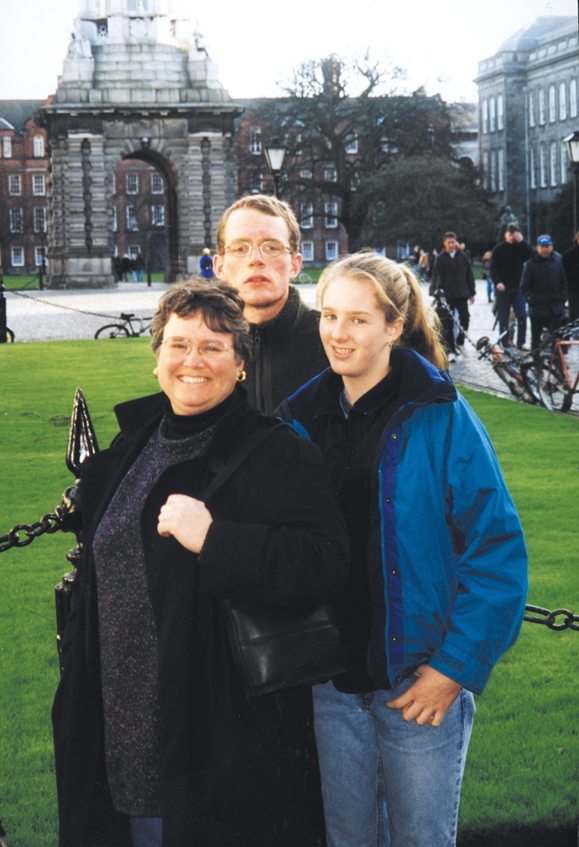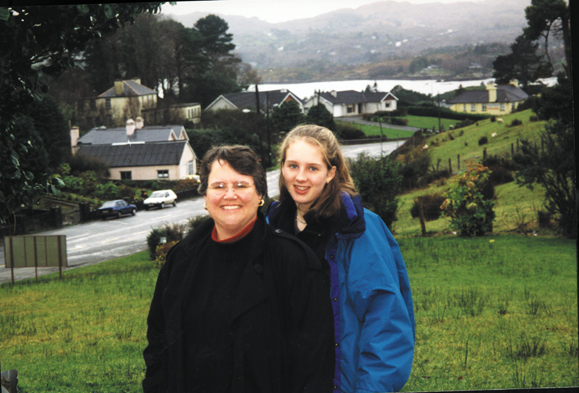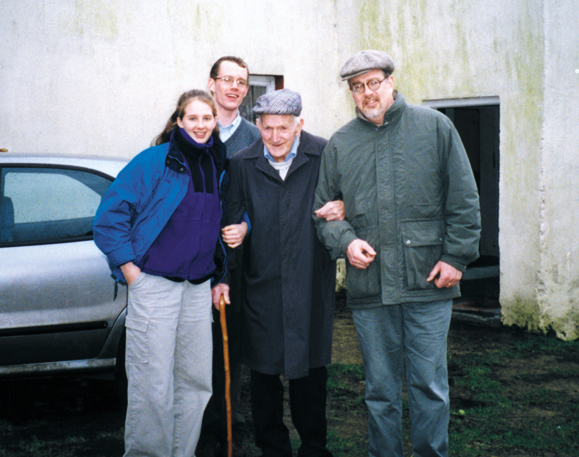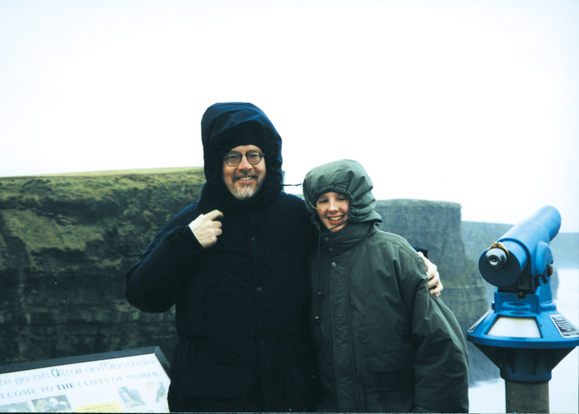Ireland offers a warm welcome, even in winter.
Dublin: The wind and rain lashed furiously on the tarmac at Dublin Airport, rocking our Aer Lingus Airbus like a gondola exposed to the elements on a mountaintop. We hadn’t packed any sun block for this post-Christmas 2000 family trip to Ireland, but no one had told us we’d be landing in the monsoon season. It had proved impossible to land at Shannon Airport in the west, where the storm was said to be really raging. What had possessed us to think that taking our children at Christmastime to see Ireland for the first time made any sense at all? As a Muzak reel of Christmas carols piped us off the Airbus, I wondered: Can you get seasick on an airplane at the gate?
Not that folks hadn’t tried to warn us. Everybody said the weather in Ireland at the outset of winter would be miserable -even the innkeepers we called to book rooms. Gusts had reached 100 mph in the west the previous day. The drenched ground crew in their yellow slickers looked like fishermen waiting to tie down the last ship in the fleet.
But what the heck? Most of the things we wanted to see, from the Book of Kells to Bunratty Castle, were indoors anyway. This was an adventure and a well-earned break for the Connells. I was a recovering journalist, about to embark on a new life as an independent writer after a quarter century in the daily news grind. Nancy and I had last been in Ireland together two decades earlier, the summer before our first child, Matthew, was born. Now Matt, 19, home from college for the holidays, and Ellen, 13, were getting a glimpse of the land where their grandmother grew up and where unseen uncles, aunts, and cousins still lived. Our third child, James, 18, was back home rowing with his college crew team.
We encounter a few disappointments on our Yuletide tourist trek. The library that houses the Book of Kells at Trinity College in the middle of Dublin was locked tight for the week between Christmas and New Year’s. There were no banquets or songs at Bunratty Castle just outside Limerick, either. But the off-season traveler quickly learns to appreciate the myriad of other sights that can be enjoyed without the bustling crowds of spring and summer. As for the weather, we paid it no never mind. The thermometer never sank close to freezing during our week in Ireland, and three days were brilliant — sunnier by far than many a July day I have passed in Ireland. There were vacancies galore and plenty to do, notwithstanding the occasional CLOSED sign. We weren’t the only ones taken aback by Trinity College’s and the keeper of the Kells’ strict observance of the holiday. Two dozen foreign students were turned away at the same time, equally surprised and disappointed at missing a glimpse of the monks’ colorful calligraphy. The stage was dark at the Abbey, but a few blocks up O’Connell Street the Gate Theater mounted a stirring production of Rostand’s Cyrano de Bergerac. We saw golden antiquities and relics at the National Museum, and had a delightful tour of Dublin Castle, led by a witty, feminist guide who remarked as she pointed out former President Mary Robinson’s coat of arms that the incumbent Irish president “is also a woman -thank God!” We dispensed with the Guinness Brewery tour (but not with the Guinness — it’s good for you), but made the ritual trek to Christchurch and St. Patrick’s Cathedrals, where the 18th century dean and his wife are buried “where fierce indignation can no more lacerate his heart.”
We also skipped St. Michan’s Church, on whose regal organ Handel is said to have composed The Messiah. St. Michan’s is also Dublin’s answer to the Tomb of Tutankhamen: its basement houses a collection of mummified bodies, preserved by the limestone in these dry vaults. The largest and most famous tenant in St. Michan’s basement is affectionately called the Crusader (the late 17th century church is built atop the ruins of an earlier place of worship that the Vikings built 900 years ago). I shook the Crusader’s leathery hand back in December 1970 at the end of a five-month stay in Ireland as a college student. When I climbed out of the crypt and into the sunshine that day, a nasty cold that had been making my final days in Ireland a misery almost miraculously went away. We were told some vandals had made a mess of St. Michan’s a few years back; I hope they left the Crusader his dignity.

Most of my previous half-dozen trips to Ireland were in the 1970s, although I was back briefly in 1993 on my mother Mary’s last trip home. She is 90 now and living in an assisted living facility in New Jersey, with few physical infirmities but bereft of memory. No longer can she recite the poems learned in the one-room schoolhouse near the County Cork farm where her widowed mother raised six youngsters. My kids had never met her two surviving brothers: Sean McSweeney, a retired schoolmaster and raconteur, and Jimmy McSweeney, the wry, gentle bachelor left to work the family farm outside Dunmanway when flu carried off the eldest brother, Con, in the 1920s.
We had rooms booked at the Golf Links Hotel in Glengariff for New Year’s Eve, but a jammed lock on the rented Opel Astra foiled our plans for an early departure from Dublin. The lady at the desk at Talbot’s Guest House abandoned her post to try her hand, but she had no more luck than I. We called the AA, which promised to dispatch someone within the hour. He took 90 minutes, but had the door open in a trice. Ireland was still soaking this morning from the gales of the two previous days, and the main roads in the south and west were flooded. Fermoy, which straddles the main road south, was laying claim this morning to being the Irish Venice, so we charted a new course west through Limerick, Killarney, and over the Caha Mountains to Glengariff. How long would this take, Nancy and the kids asked. It was just a couple of hundred miles. Five or six hours, I guessed.
I wasn’t counting on the dual carriageway disappearing and traffic grinding to a halt in Kildare. It was dark before we reached Limerick. We pressed on relentlessly to Killarney, where I made a couple of wrong turns before Matthew (born with a compass in his head) set us right again. Nancy wondered what was wrong with all the choice lodgings we were passing up. But this was New Year’s Eve, and we had an appointment in Glengariff. It was 8 p.m. before we reached Kenmare, and suddenly I recalled the manager from the Golf Links telling me their restaurant was fully booked that evening, and she could only feed us if we got there early. That was not going to happen. Out of the car we clambered and down the street to a hotel with a crowded bar, where the first words out of the barmaid’s mouth were, “It’s a fixed-price menu only tonight — and we’re fully booked.” I felt panic set in as we headed back toward the street, wondering if we’d wind up ringing in the New Year with fish and chips from a greasy spoon.
Then the barmaid hurtled back to intercept us: “Wait! The cook says we have a cancellation.” The meal that followed was a delight. It started with a prodigious Caesar salad, with chopped walnuts and cheese, and the best brown bread in Ireland. Nancy and Matt dined on chicken and I feasted on salmon in a wine sauce worth slurping with a spoon. There were plates of potatoes -fried and browned in the oven — as well as turnips and small, tasty Brussels sprouts. The prix fixe of 12 pounds (about $16) included pints of Murphy’s Stout. Our vegetarian 13-year-old, who’d been subsisting largely on bread, butter and scones, was charged only for the plate of chips.
Fully restored, we made it over the mountain, past the grazing sheep with red and blue splotches of paint on their backs and into Glengariff without incident a little past 10 p.m. — 10 hours after we set out. The Golf Links Hotel beckoned us at the top of a lane, with a Christmas tree in the porch and peals of laughter in the bar. Helen, the manager, found us three rooms and we ushered in the New Year in style. In the morning we awoke to discover the beauty of Bantry Bay outside our windows. We made our getaway a good bit earlier than poor Helen, who had been up until 4:30 a.m. tending the holiday revelers, had a right to expect. She served us our tea and breakfast, then tallied the bill.
We were up early on this New Year’s Day to rendezvous at the farm where my mother was born at a bend in the road called Inchincurka, five miles north of Dunmanway. My cousin John, an American-born rebel who emigrated from the Bronx at the age of eight, would be there with Uncle Jimmy, the reluctant farmer who now spends his days in a nursing home in Clonakilty. It was a cold, wet holiday, and we found Jimmy warming by the peat fire in the pale, cream-colored farmhouse where he dwelled all but five of his 89 years.

The farmhouse is mostly empty these days, and another farmer tills the rocky West Cork fields. John now owns the house and 58 acres of land where he came of age after deciding back in the summer of 1948 that the Bronx was not his cup of tea. John was one of four children of my Uncle Patrick McSweeney, a postal supervisor, and his wife, Hannie. Uncle Patrick — Patsy — the oldest of my mother’s five siblings, had come to America first and endured hard times in the Depression before finding work with the Post Office and raising his family in a three-room apartment opposite Our Lady of Refuge Church on Briggs Avenue. The quarters were too close for John. He saw his opportunity to escape when my mother took him and my two older siblings back to see her mother and brother on the farm outside Dunmanway in 1948. It was a difficult summer. Both of her own toddlers came down with whooping cough. And at the end of their stay, young John announced that he was staying put. When he refused to board the tender at Cobh for the homeward journey, my mother wired Patsy and Hannie and asked what to do. Leave him there for the winter, they wired back. We’ll go over next summer and bring him home.
But John was home. He stayed on the farm with Jimmy and Grandma, who was happy to raise another child 40 years after her last was born in Inchincurka. John became an Irishman and today manages a plant in Dublin, where he and wife Patricia have raised their own four sons. He visits Inchincurka on weekends and holidays and harbors ambitions of installing central plumbing and heating and turning the century-old stucco farmhouse into his own retirement home.
Inchincurka looks much as I remembered from my first visit as a 13-year-old in 1963: the spare, chilly kitchen with running water the sitting room where Jimmy would build roaring fires with wads of the Cork Examiner and turf cut by his own hand from the land near the Caha River; a parlor reserved for ceremonial occasions (and now completely bare), and three bedrooms with mattresses en dishabille, to say the least. Jimmy, at 50, was delighted to have company once again back on the farm. He gave my sister Alice and me driving lessons, letting us tool around the countryside in his vintage, black Morris Minor. He also gave me the key to the tractor, which I managed to get stuck in the mud down by the river in the lower fields. Jimmy never raised his voice. He didn’t let minor disasters bother him. Of course, his ears were so full of wax you had to raise your voice so he could hear you. A few years later, he put aside his natural aversion to doctors long enough to have his ears cleaned at a doctor’s office in Cork. He left the doctor and nurses in stitches with his jocular complaints about all the fierce noise he now could hear on the streets below — just the normal sounds of traffic.
My grandmother had died in 1955, and the old farmhouse quickly degenerated into bachelor digs under Jimmy’s relaxed rule. The only serious cleaning was when my mother or Hannie came to visit, or when there was a station — a priest saying Mass in the living room, and a feast afterwards for the neighbors. The part of farming that Jimmy hated most was milking the cows — the dozen smelly animals that provided most of his income, but also were a yoke around his shoulders. Morning and evening they summoned him to the shed to be milked. If was a hardscrabble life that Jimmy led with his dogs, all of whom he called Shep. Jimmy was a non-card-carrying Pioneer who loved a good laugh and showed us kids no quarter in card games of 110. You can’t blame him if he felt envious of the brother who became a schoolmaster or of Patsy and Mary who escaped to make their fortunes in the new world. And you can’t blame them if they in turn envied Jimmy, living carefree in the beauty and serenity of the Irish countryside, while they faced a legion of children every morning or rode to work on the crowded subways in New York.

We found to our delight that Jimmy had lost neither his memory nor his smile. He recognized Nancy, whom he had not seen in 20 years. The kids he had never seen, but they laughed as I did 35 years ago at the lamentations in that rich Cork accent about the fierce, hard life of the farmer.
Later, between downpours, we searched in the Kilmichael graveyard for the grave of my grandfather, James McSweeney, whom we know only by a photograph of a dashing figure in Philadelphia, where he ventured briefly before returning to Ireland and dying young.
We never did find the right one. Jimmy was waiting in the car; it was hours past his usual dinnertime at the nursing home in Clonakilty. We couldn’t tarry, so we left the search for another year. We drove off to Macroom for dinner, and then bade good-bye in the rain to Jimmy and John.
Matthew had purchased two Ordnance Survey maps of West Cork. Inchincurka sits on the border of maps 85 and 86, with the farmhouse and every other dwelling in these rugged lands east of the Shehy Mountains marked with its own black sliver. All the villages and byways that figured in the stories Jimmy, Sean and my mother used to tell, from Kilnadur and Gortroe to Kealkill and Capeen — not one had been missed by the Ordnance Survey. Matt discovered that the fields and hillsides where Grandma played as a girl were thick with ancient stones, burial mounds and other monuments from several millennia before Christ.
Her brother Sean, the schoolmaster, could have led us to many of those sights without a map had we come a few years earlier. At 93, his memory, too, was gone, and we found him confined to bed in Ovens with a chest cold and low fever. We kept the visit brief. His handshake was still firm and his eye curious. He guessed that Matthew and Ellen were in their 20s. We left a bottle of whiskey, which he would have gladly passed around in earlier days — and not all that much earlier. Just the week before, the family had left him asleep in the house at midday while they attended to errands -and returned to find him walking down the road in his nightclothes, resuming his daily pilgrimage to the pub at Kilumney.
In 1970, I had landed in on Sean, Joan and their three teenagers for what was supposed to be a two-week stay in August — and extended it until December. Joan, herself now retired from teaching, was quick to regale my two children with tales of how scandalized the neighbors were by this American “hippie.” I was a poor excuse for a hippie, but perhaps the Irish were more easily scandalized in those days.
(As it turned out, this was Uncle Sean’s final bout of illness. He passed away two weeks later, surrounded by family. The church at Ovens was filled with generations of his pupils.
We could not get back to Ireland for the service, but I was so glad to have had the chance to say good-bye, and for the kids to meet the schoolmaster in the family. It was yet another reason why the timing for this trip, which at first seemed so strange, turned out perfect.)
Nancy came to Ireland with bronchitis, and our travels had done nothing to improve her condition. She sat bundled in the car and napped while Matthew, Ellen and I clambered up the narrow, winding steps at Blarney Castle. At the top, a guide in yellow rain slicker waited on the narrow walkway at the top of the castle’s battlements where the Blarney Stone is ensconced. Ellen and I observed the tradition, which involves sitting down on the guide’s mat, arching your head back, clutching some rails and pulling yourself down a foot or two to kiss the stone while ignoring the remote possibility that you might soon be kissing the green grass six stories below if the attendant lets you slip through the cavity. Matthew decided that the gift of the gab was not worth this risk, so he left without planting his lips on the stone of legend.
On Sunday morning, as we were about to decamp from a guesthouse in Ballincollig, Nancy was running a fever. The landlady of Westfield House, Rose Cotter — just back from her own family’s skiing vacation in Italy — rang her doctor. In a short while — far less time than it took for the motorists’ helper to arrive in Dublin — Dr. M.F. Ryan was knocking at the door. Dr. Ryan was a cheery soul who gave the impression there was no finer way to spend a Sunday morning than running around Ballincollig with a medical kit, listening to phlegmy lungs. Nancy had come to Ireland with an antibiotic spray that had been dispensed back in the States. He quickly diagnosed Nancy’s problem as failure to ingest enough of this spray. He dismissed as “nonsense” the advice she had gotten back home to hold the inhaler three inches from her mouth. To drive his message home, he darted downstairs to his car and returned in triumph with his personal inhaler, which he proceeded to suck in with enough force to deflate the Goodyear Blimp. After this tutelage, he penned a couple of prescriptions and departed.
And we took our leave of Cork, driving north to Limerick through Blarney over back roads with the help of a stranger’s directions illustrated on the back of a pharmacy slip. The Michelin Green Guide listed just one principal attraction between Blarney and Limerick: the 13th century Dominican Abbey in Kilmallock, just down the road from Bruree, where another reverse immigrant from America, Eamon de Valera, was schooled. The weather was dismal, but the ruins of the Abbey were breathtaking, setting me to wonder once again just how much of Ireland I had missed before while making multiple treks around the Ring of Kerry and the Dingle peninsula.
Dingle, in fact, was on the original itinerary for this winter solstice trip, since Matthew, an amateur linguist, wanted to immerse himself in the Gaeltacht. He was dismayed to find no one we encountered in Cork speaking Gaelic. The bilingual road signs were small consolation, and the evening news in Gaelic on Radio Telefis Eireann did not suffice. Matthew already had learned more Gaelic words from dictionaries back home than I had picked up in all my trips to Ireland.
However, Dingle and the beehive huts near Dunquin were not to be reached on this short visit. After enduring the 10-hour cross-country dash on New Year’s Eve, my family rebelled: no long car rides on our final day in Ireland, they insisted. Only Ellen came along when I set out for my final tourist destination: the Cliffs of Moher. And the highlight on that jaunt turned out not to be those beautiful green promontories jutting into the Atlantic, but an impromptu stop at a farmhouse in Doonbeg where 20 cattle were huddled around feeders. We stopped to take a picture, and Patricia McInerny emerged from the farmhouse to greet us. Three wiggling dogs on a haystack in the barn beside a stack of rough-cut peat made up the rest of the greeting party. There was a skittish cat, too, but the pups chased it off. Mrs. McInerny said they had more cows than usual this winter: prices were so low they kept the bullocks to fatten away the winter on Doonbeg hay. “And they’ll probably be lower still this year,” she said with a rueful smile. Her husband makes his living driving a lorry, not off their 60 acres. “Soon there won’t be any farmers left,” said Mrs. McInerny, in the lament of farmers everywhere. But life in Doonbeg did not look too bleak on this blustery morning. Notwithstanding the towering stack of peat, the McInerneys just installed oil heat in their house.
And so it seemed everywhere our travels took us. Ireland has changed from a country where vintage Morris Minors and Beetles roamed the roads to one where parking jams are commonplace and everyone seems to be driving late model Camrys, Fiestas, Astras and even Land Cruisers. From Grafton Street in Dublin to O’Connell Street in Limerick, the Irish, young and old, looked smartly dressed and in a hurry to get someplace. And when the receipt for your Guinness and Seven-Ups from Flanagan’s Bar in Kilmallock comes printed in euros as well as punts, it is just another vivid reminder that Ireland is knit now to a large and prospering continent.
Back in Limerick, the restaurant in the King George Hotel resolutely played carols, 10 days past Christmas. We slipped away the next morning before dawn, steering our course down a deserted highway past Bunratty Castle to Shannon, where elaborate neon holiday decorations — the distinctive outlines of the Houses of Parliament, the Statue of Liberty and other distant landmarks — guided us in to the terminal.
It was the eve of Epiphany, and Frosty the Snowman was still hippety hopping on the same Muzak Christmas tape over the loudspeaker of our Aer Lingus jet. In America, stores would have torn down the Christmas decorations and stocked their shelves already for the next big commercial celebration, Valentine’s Day. But the holidays last longer in Ireland. It’s a new country, but still in touch with the old verities. We had come to Ireland at Christmastime to find family and heritage, and we had not been disappointed.♦


Leave a Reply